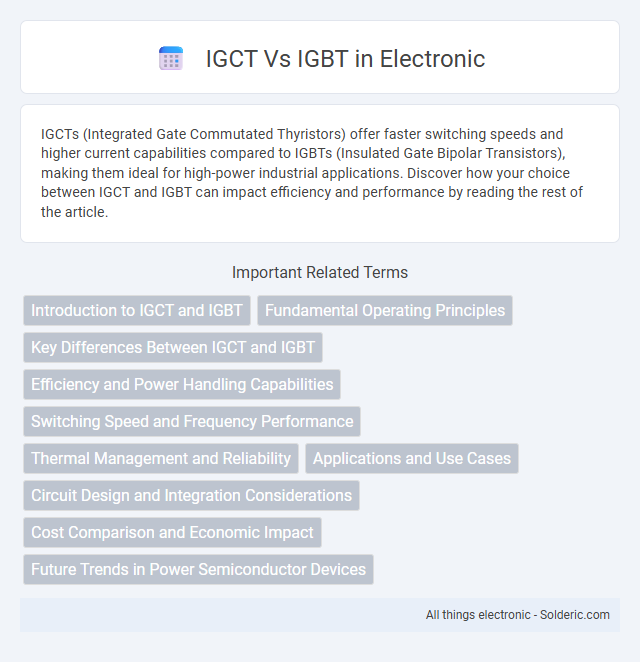IGCTs (Integrated Gate Commutated Thyristors) offer faster switching speeds and higher current capabilities compared to IGBTs (Insulated Gate Bipolar Transistors), making them ideal for high-power industrial applications. Discover how your choice between IGCT and IGBT can impact efficiency and performance by reading the rest of the article.
Comparison Table
| Feature | IGCT (Integrated Gate Commutated Thyristor) | IGBT (Insulated Gate Bipolar Transistor) |
|---|---|---|
| Type | Thyristor-based power semiconductor device | Bipolar transistor with insulated gate |
| Switching Speed | High-speed, faster than traditional thyristors | Moderate to high switching speed |
| Voltage Rating | Typically 2.5 kV to 6.5 kV | Typically 600 V to 1.7 kV |
| Current Rating | Very high, often several kiloamperes | High, typically up to several hundred amperes |
| Turn-off Capability | Self turn-off via gate commutation | Turn-off controlled by gate voltage |
| Application | High-power traction drives, industrial inverters, HVDC converters | General purpose inverters, motor drives, power supplies |
| Conduction Losses | Lower conduction losses compared to IGBT | Higher conduction losses than IGCT |
| Cost | Higher cost due to complexity | Lower cost, widely used |
| Robustness | Highly robust for high power and voltage | Robust but less so at very high voltage/current |
Introduction to IGCT and IGBT
IGCT (Integrated Gate-Commutated Thyristor) and IGBT (Insulated Gate Bipolar Transistor) are advanced semiconductor devices used for high-power switching applications. IGCTs provide ultra-fast switching, low conduction losses, and high current capability, making them ideal for industrial motor drives and traction systems. Your choice between IGCT and IGBT depends on specific requirements like switching speed, voltage ratings, and efficiency in power conversion systems.
Fundamental Operating Principles
IGCT (Integrated Gate-Commutated Thyristor) operates using a combination of thyristor and transistor characteristics, enabling fast gate-controlled turn-off by injecting a reverse current to quickly interrupt conduction. IGBT (Insulated Gate Bipolar Transistor) functions as a voltage-controlled device combining MOSFET input with bipolar output characteristics, allowing efficient switching through gate voltage modulation without the need for reverse current. Understanding these fundamental operating principles helps you choose the ideal semiconductor device for high-power, high-speed switching applications.
Key Differences Between IGCT and IGBT
IGCT (Integrated Gate Commutated Thyristor) offers superior high-power handling and faster switching compared to IGBT (Insulated Gate Bipolar Transistor), making it ideal for industrial applications requiring high efficiency and reliability. IGBTs excel in medium-power applications with simpler drive requirements and lower cost, providing better performance in lower frequency switching. The main distinction lies in IGCT's ability to handle higher current densities and faster turn-off times, while IGBTs are favored for versatility and ease of use in power electronics.
Efficiency and Power Handling Capabilities
IGCTs (Integrated Gate Commutated Thyristors) offer higher efficiency and superior power handling capabilities compared to IGBTs (Insulated Gate Bipolar Transistors), making them ideal for ultra-high power applications such as industrial drives and HVDC systems. With their low conduction and switching losses, IGCTs enable better thermal management and sustained operation under heavy load conditions. Your choice between IGCT and IGBT depends on whether ultra-high power efficiency or versatility and cost-effectiveness are the primary requirements for your application.
Switching Speed and Frequency Performance
IGCTs (Integrated Gate Commutated Thyristors) offer slower switching speeds compared to IGBTs (Insulated Gate Bipolar Transistors), typically operating efficiently at frequencies up to 2 kHz. IGBTs excel in high-frequency applications, functioning effectively at switching frequencies from tens to hundreds of kilohertz, making them ideal for your high-speed power electronics needs. Choosing between IGCT and IGBT depends on whether your application prioritizes high current handling with moderate switching speeds or high-frequency switching performance.
Thermal Management and Reliability
IGCTs offer superior thermal management due to their lower switching losses and higher current density, enabling more efficient heat dissipation compared to IGBTs. The robustness of IGCTs enhances their reliability in high-power applications, where thermal stress can significantly impact device lifespan. IGBTs, while versatile, often require more complex cooling systems to maintain optimal operating temperatures and ensure long-term reliability under heavy loads.
Applications and Use Cases
IGCTs (Integrated Gate Commutated Thyristors) are commonly used in high-power applications such as industrial motor drives, traction systems, and high-voltage DC transmission due to their ability to handle very high current and voltage levels with fast switching capabilities. IGBTs (Insulated Gate Bipolar Transistors) dominate medium- to high-power applications like renewable energy inverters, electric vehicles, and power supplies because of their efficient switching performance and ease of control. While IGCTs excel in applications requiring robust high-current handling and ruggedness, IGBTs are preferred for versatile, cost-effective solutions in fast-switching and lower-power environments.
Circuit Design and Integration Considerations
IGCTs offer faster switching speeds and lower conduction losses, making them ideal for high-power, high-efficiency circuit designs, while IGBTs provide simpler gate drive requirements and are better suited for moderate switching frequencies. Your circuit integration must consider IGCTs' complex gate drive circuits and the need for precise timing to optimize performance, whereas IGBTs allow easier integration in compact designs with less sensitive control. Selecting between IGCT and IGBT depends on balancing system efficiency, switching frequency, and the complexity of control circuitry in your application.
Cost Comparison and Economic Impact
IGCTs generally have higher initial costs compared to IGBTs due to complex manufacturing processes and specialized materials. However, IGCTs offer superior performance in high-power applications, potentially reducing system-level expenses through enhanced efficiency and longer lifespan. Choosing between IGCT and IGBT requires analyzing total cost of ownership, including energy savings, maintenance, and reliability factors that impact long-term economic outcomes.
Future Trends in Power Semiconductor Devices
IGCT and IGBT technologies continue evolving to meet rising demands for higher efficiency and faster switching in power semiconductor devices. Future trends emphasize wide bandgap materials like SiC and GaN, which outperform traditional IGCT and IGBT by enabling lower losses and higher thermal stability. Optimizing Your power systems involves selecting devices that balance switching speed, voltage ratings, and robustness for next-generation energy applications.
IGCT vs IGBT Infographic

 solderic.com
solderic.com